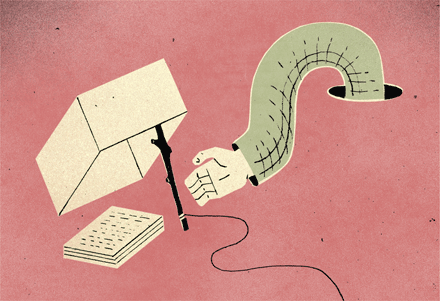
© DAVID PLUNKERTA spoof paper concocted by Science reveals little or no scrutiny at many open-access journals.
On 4 July, good news arrived in the inbox of Ocorrafoo Cobange, a biologist at the Wassee Institute of Medicine in Asmara. It was the official letter of acceptance for a paper he had submitted 2 months earlier to the
Journal of Natural Pharmaceuticals, describing the anticancer properties of a chemical that Cobange had extracted from a lichen.
In fact, it should have been promptly rejected.Any reviewer with more than a high-school knowledge of chemistry and the ability to understand a basic data plot should have spotted the paper's short-comings immediately.
Its experiments are so hopelessly flawed that the results are meaningless.I know because I wrote the paper. Ocorrafoo Cobange does not exist, nor does the Wassee Institute of Medicine. Over the past 10 months, I have submitted 304 versions of the wonder drug paper to open-access journals.
More than half of the journals accepted the paper, failing to notice its fatal flaws. Beyond that headline result, the data from this sting operation reveal the contours of an emerging Wild West in academic publishing.
From humble and idealistic beginnings a decade ago, open-access scientific journals have mushroomed into a global industry, driven by author publication fees rather than traditional subscriptions. Most of the players are murky. The identity and location of the journals' editors, as well as the financial workings of their publishers, are often purposefully obscured. But
Science's investigation casts a powerful light. Internet Protocol (IP) address traces within the raw headers of e-mails sent by journal editors betray their locations. Invoices for publication fees reveal a network of bank accounts based mostly in the developing world. And the acceptances and rejections of the paper provide the first global snapshot of peer review across the open-access scientific enterprise.
One might have expected credible peer review at the
Journal of Natural Pharmaceuticals. It describes itself as "a peer reviewed journal aiming to communicate high quality research articles, short communications, and reviews in the field of natural products with desired pharmacological activities." The editors and advisory board members are pharmaceutical science professors at universities around the world.


Comment: Ifs, buts and maybes in this game of cosmic roulette have periodically become dead certainties in the course of human history - the collapse of civilizations in the past coincided with Earth encountering larger swarms of cometary and asteroid debris... like the planet is encountering now.